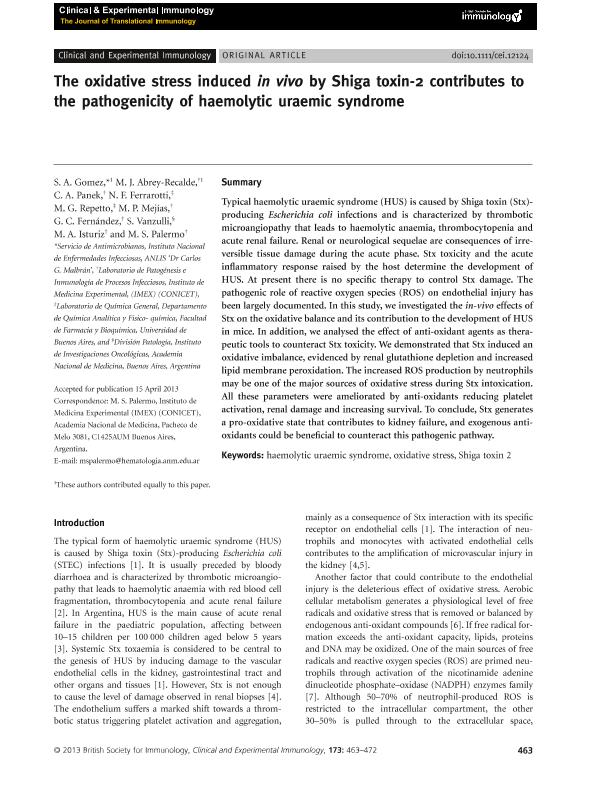Artículo
The oxidative stress induced in vivo by Shiga toxin-2 contributes to the pathogenicity of haemolytic uraemic syndrome
Gómez, Sonia Alejandra ; Abrey Recalde, Maria Jimena
; Abrey Recalde, Maria Jimena ; Panek, Cecilia Analía
; Panek, Cecilia Analía ; Ferrarotti, Nidia Fatima; Repetto, Marisa Gabriela
; Ferrarotti, Nidia Fatima; Repetto, Marisa Gabriela ; Mejias, María Pilar
; Mejias, María Pilar ; Fernández, Gabriela Cristina
; Fernández, Gabriela Cristina ; Vanzulli, Silvia; Isturiz, Martín Amadeo
; Vanzulli, Silvia; Isturiz, Martín Amadeo ; Palermo, Marina Sandra
; Palermo, Marina Sandra
 ; Abrey Recalde, Maria Jimena
; Abrey Recalde, Maria Jimena ; Panek, Cecilia Analía
; Panek, Cecilia Analía ; Ferrarotti, Nidia Fatima; Repetto, Marisa Gabriela
; Ferrarotti, Nidia Fatima; Repetto, Marisa Gabriela ; Mejias, María Pilar
; Mejias, María Pilar ; Fernández, Gabriela Cristina
; Fernández, Gabriela Cristina ; Vanzulli, Silvia; Isturiz, Martín Amadeo
; Vanzulli, Silvia; Isturiz, Martín Amadeo ; Palermo, Marina Sandra
; Palermo, Marina Sandra
Fecha de publicación:
08/2013
Editorial:
Wiley Blackwell Publishing, Inc
Revista:
Clinical and Experimental Immunology
ISSN:
0009-9104
Idioma:
Inglés
Tipo de recurso:
Artículo publicado
Clasificación temática:
Resumen
Typical haemolytic uraemic syndrome (HUS) is caused by Shiga toxin (Stx)- producing Escherichia coli infections and is characterized by thrombotic microangiopathy that leads to haemolytic anaemia, thrombocytopenia and acute renal failure. Renal or neurological sequelae are consequences of irreversible tissue damage during the acute phase. Stx toxicity and the acute inflammatory response raised by the host determine the development of HUS. At present there is no specific therapy to control Stx damage. The pathogenic role of reactive oxygen species (ROS) on endothelial injury has been largely documented. In this study, we investigated the in-vivo effects of Stx on the oxidative balance and its contribution to the development of HUS in mice. In addition, we analysed the effect of anti-oxidant agents as therapeutic tools to counteract Stx toxicity.We demonstrated that Stx induced an oxidative imbalance, evidenced by renal glutathione depletion and increased lipid membrane peroxidation. The increased ROS production by neutrophils may be one of the major sources of oxidative stress during Stx intoxication. All these parameters were ameliorated by anti-oxidants reducing platelet activation, renal damage and increasing survival. To conclude, Stx generates a pro-oxidative state that contributes to kidney failure, and exogenous antioxidants could be beneficial to counteract this pathogenic pathway.
Palabras clave:
SHIGA TOXIN-2
,
HAEMOLYTIC URAEMIC SYNDROME
,
OXIDATIVE STRESS
Archivos asociados
Licencia
Identificadores
Colecciones
Articulos(IMEX)
Articulos de INST.DE MEDICINA EXPERIMENTAL
Articulos de INST.DE MEDICINA EXPERIMENTAL
Articulos(SEDE CENTRAL)
Articulos de SEDE CENTRAL
Articulos de SEDE CENTRAL
Citación
Gómez, Sonia Alejandra; Abrey Recalde, Maria Jimena; Panek, Cecilia Analía; Ferrarotti, Nidia Fatima; Repetto, Marisa Gabriela; et al.; The oxidative stress induced in vivo by Shiga toxin-2 contributes to the pathogenicity of haemolytic uraemic syndrome; Wiley Blackwell Publishing, Inc; Clinical and Experimental Immunology; 173; 3; 8-2013; 463-472
Compartir
Altmétricas



